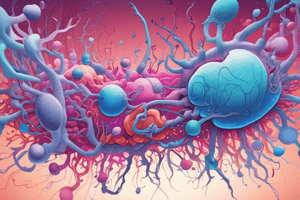Podcast
Questions and Answers
What is the primary function of intact skin and mucous membranes in the body?
What is the primary function of intact skin and mucous membranes in the body?
- To prevent the growth of fungi and bacteria (correct)
- To promote the repair of damaged tissue
- To produce antibodies in response to an antigen
- To stimulate the inflammatory response
What is the effect of the dryness of the skin on bacteria?
What is the effect of the dryness of the skin on bacteria?
- It destroys bacteria
- It inhibits the growth of bacteria (correct)
- It promotes the growth of bacteria
- It has no effect on bacteria
What is the role of resident bacteria on the skin?
What is the role of resident bacteria on the skin?
- They prevent other bacteria from multiplying (correct)
- They promote the inflammatory response
- They cause infection and disease
- They produce antibodies in response to an antigen
What is the characteristic of normal secretions of the skin?
What is the characteristic of normal secretions of the skin?
What is the purpose of inflammation in the body?
What is the purpose of inflammation in the body?
What are the five signs of inflammation?
What are the five signs of inflammation?
What is the meaning of the suffix -it is in medical terms?
What is the meaning of the suffix -it is in medical terms?
What type of immunity is produced by the body in response to an antigen?
What type of immunity is produced by the body in response to an antigen?
What is the duration of natural active immunity?
What is the duration of natural active immunity?
What is the purpose of administering antigens or toxoids to stimulate antibody production?
What is the purpose of administering antigens or toxoids to stimulate antibody production?
Flashcards are hidden until you start studying
Study Notes
Asepsis and Infection Control
- Midwives play a crucial role in maintaining a biologically safe environment by controlling the spread of microorganisms.
- Microorganisms are everywhere, including on body surfaces, in water, and in soil, but most are harmless and some are even beneficial.
Types of Microorganisms that Cause Infections
- Bacteria are the most common infection-causing microorganisms, with hundreds of species capable of causing disease in humans.
- Viruses, including rhinovirus, hepatitis, herpes, and human immunodeficiency virus, rely on living cells to reproduce.
- Fungi, such as Candida albicans, are normally found in the human vagina, while parasites, including protozoa, helminths, and arthropods, live on other living organisms.
Asepsis
- Asepsis is the freedom from disease-causing microorganisms, achieved through aseptic technique to prevent the transmission of microorganisms.
- Medical asepsis involves practices that confine microorganisms to a specific area, limiting their number, growth, and transmission.
- Surgical asepsis, or sterile technique, involves practices that keep an area or object free of all microorganisms, including practices that destroy all microorganisms and spores.
Chain of Infection
- The chain of infection consists of six links: the etiologic agent, reservoir, portal of exit, method of transmission, portal of entry, and susceptibility of the host.
- The etiologic agent is the microorganism capable of producing an infectious process, depending on factors such as virulence, potency, and ability to enter the body.
- Reservoirs of microorganisms include humans, animals, plants, and the environment, with people being the most common source of infection for others and themselves.
Portal of Exit from Reservoir
- Before an infection can establish itself in a host, the microorganism must leave the reservoir through a portal of exit.
Method of Transmission
- There are three mechanisms of transmission: direct, indirect (vehicle-borne or vector-borne), and airborne.
- Direct transmission involves immediate and direct transfer of microorganisms from person to person through touching, biting, kissing, or sexual intercourse.
- Indirect transmission involves a vehicle (e.g., food, water, fomites) or vector (e.g., insect) to transport the infectious agent.
Nonspecific Defenses
- Nonspecific body defenses include anatomic and physiological barriers and the inflammatory response.
- Intact skin and mucous membranes are the body's first line of defense against microorganisms, preventing bacteria and fungi from penetrating.
- The immune system uses nonspecific defenses, such as the inflammatory response, to defend against infection.
Inflammatory Response
- Inflammation is a local and nonspecific defensive response to an injurious or infectious agent, characterized by pain, swelling, redness, heat, and impaired function.
Types of Immunity
- There are two types of immunity: active and passive.
- Active immunity involves the production of antibodies by the body in response to an antigen, either naturally through infection or artificially through vaccination.
- Passive immunity involves the transfer of antibodies from another source, providing short-term protection.
Studying That Suits You
Use AI to generate personalized quizzes and flashcards to suit your learning preferences.




